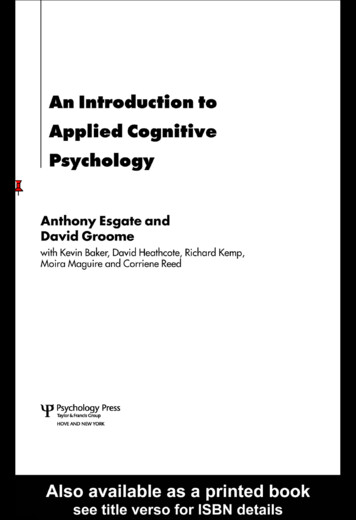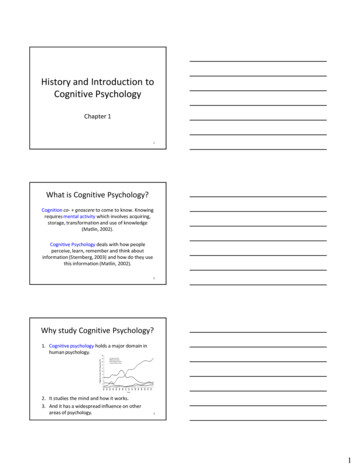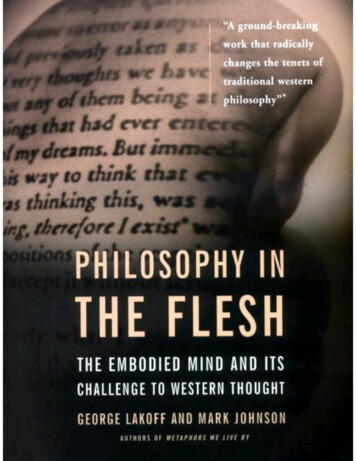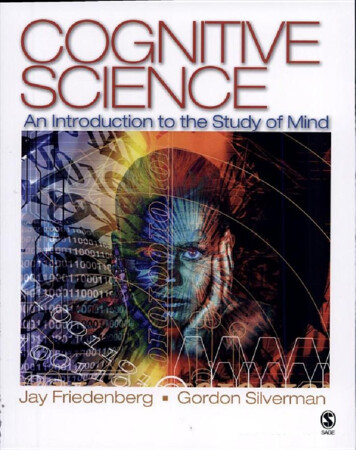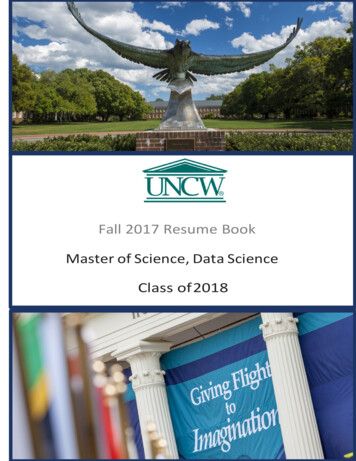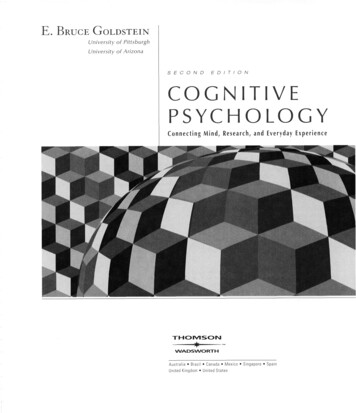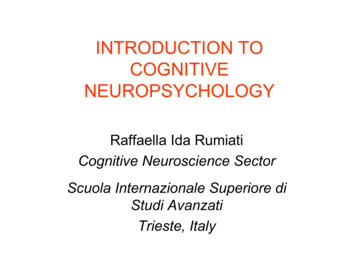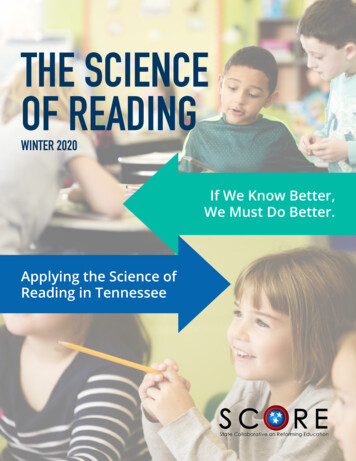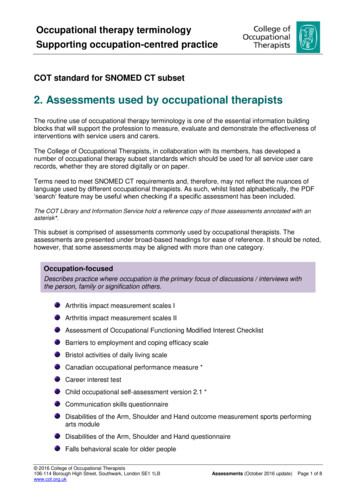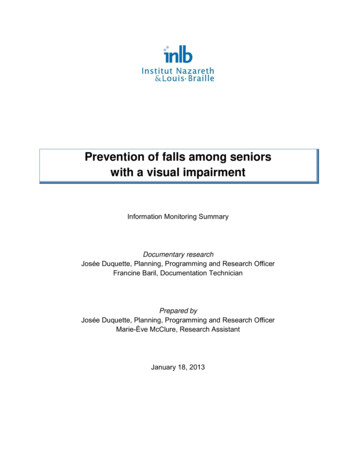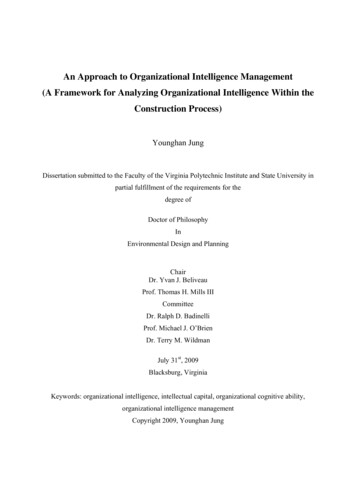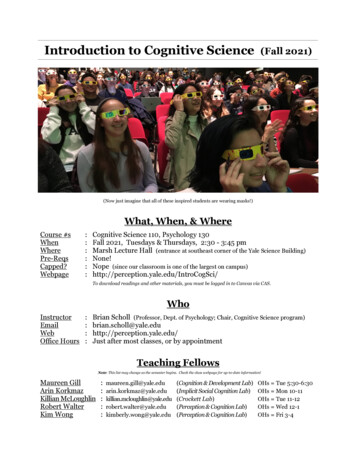
Transcription
Introduction to Cognitive Science(Fall 2021)(Now just imagine that all of these inspired students are wearing masks!)What, When, & WhereCourse #sWhenWherePre-ReqsCapped?Webpage::::::Cognitive Science 110, Psychology 130Fall 2021, Tuesdays & Thursdays, 2:30 - 3:45 pmMarsh Lecture Hall (entrance at southeast corner of the Yale Science Building)None!Nope (since our classroom is one of the largest on campus)http://perception.yale.edu/IntroCogSci/To download readings and other materials, you must be logged in to Canvas via CAS.WhoInstructorEmailWebOffice Hours::::Brian Scholl (Professor, Dept. of Psychology; Chair, Cognitive Science e.edu/Just after most classes, or by appointmentTeaching FellowsNote: This list may change as the semester begins. Check the class webpage for up-to-date information!Maureen GillArin KorkmazKillian McLoughlinRobert WalterKim kimberly.wong@yale.edu(Cognition & Development Lab)(Implicit Social Cognition Lab)(Crockett Lab)(Perception & Cognition Lab)(Perception & Cognition Lab)OHs Tue 5:30-6:30OHs Mon 10-11OHs Tue 11-12OHs Wed 12-1OHs Fri 3-4
Course DescriptionWelcome! The goal of cognitive science — and of this course — is to understand how themind works. Trying to understand our own minds is perhaps the most ambitious andexciting (and difficult) project in all of science, and this project requires tools drawn fromfields including experimental psychology, computer modeling and artificial intelligence,neuroscience, philosophy, linguistics, anthropology, and behavioral economics (amongothers). This course will introduce you to the major tools and theories from these areas, asthey relate to the study of the mind. We will employ these perspectives while exploring thenature of you — focusing on parts of you such as perception, reasoning, memory,attention, imagery, language, intelligence, decision-making, morality — and even sexualattraction. In sum, this course will expose you to cognitive science, the assumptions onwhich it rests, and many of the most important and fascinating discoveries that the fieldhas made so far. By the end of our semester together, you should have gained importantnew insights into what you are and how you work!Expected Work and Grading1. (20%) Questions on Daily ReadingsTo get the most out of this course, it is essential that you carefully and critically studythe readings associated with each lecture. To encourage this — and to give theinstructor feedback as to what you thought of the material — you will be asked torespond to a brief question concerning most readings. A sample (if boring) questionmight be: “Which of the two theories discussed in this article do you think is right, andwhy?” Your answers to each question — which you must email to your specified TF nolater than one hour before the start of the class during which that reading will bediscussed — need be no longer than 1 or 2 paragraphs, and should take no longer than20 minutes to write after you have read the material. The questions due for each classwill be assigned by the end of the previous class. I will use these comments to gaugeyour reactions to (and understanding of) the ideas we’ll discuss, and I will occasionallyspend the first part of the following class responding to some of the issues you raise inthese comments. Note that a significant portion of your grade (20%) will be based onthese questions, and that late submissions will not be accepted for any reason.2. (60%) Two Exams60% of your course grade will be determined by two exams. The first exam will be onTuesday, October 19th, and will cover material from September 2nd through October14th. The second exam will be on Thursday, December 9th ( our last class meeting),and will cover material from October 26th through December 7th. The exam on whichyou do the best will count for 35% of your grade; the other will count for 25%. Therewill be no exam during the final exam period. The nature of these exams will bedescribed more fully in class. Make-up exams will be given only in exceptionalcircumstances, and in all cases may involve completely new questions, possibly inother formats. (Advice: you really want to avoid having to take a make-up exam.) Todo well on these exams, you’ll have to attend the lectures — especially since ourreadings and lectures will rarely overlap by more than 20% (since just rehearsingthe readings during our class time together wouldn’t be much fun).
3. (20%) Short PaperYou will be required to write one short (7-8 page) paper for this course, on an assignedtopic that is discussed near the end of this syllabus. This paper is due no later thanone hour before class on Thursday, November 18th ( our last class before theNovember break).ReadingsI have a low opinion of existing introductory cognitive science textbooks. But even if therewas a good one, I still wouldn’t like it — since a textbook seems like the single mostunexciting and watered-down way to discover and explore a new field. As a result, thereadings for this course have been drawn from many different sources, including textbookexcerpts, selections from popular books, articles from popular-press venues such as theNew Yorker, and many articles from the primary scientific literature (plus the occasionalmusic video!). All of the readings will be posted on our class webpage, for you to view orprint as you wish. (There is nothing to buy!) Using readings from the primary scientificliterature will help us to capture the vitality and excitement of scientific discovery.(This includes work that hasn’t yet filtered into textbooks, including readings that wereonly published very recently!) These readings will also be challenging or unsettling,though: they will use terms and refer to ideas with which you are unfamiliar, and they’llsometimes leave you with more questions than answers. This is okay! Though thereadings have been carefully chosen to be accessible, I don’t expect you to fully understandevery aspect of them, and I will frequently provide guidance about what you should try toget out of especially challenging readings. In the end, these challenges will pay off, as youget a direct look at the science of mind in the making.Preliminary Course OutlineHere’s a preliminary outline of the material that we’ll cover together this semester. The fullreferences for these readings are listed at the very end of the syllabus. We’ll start out byspending a few weeks on the key themes of cognitive science as a whole ( the glue that willtie the course together, despite so much breadth!), after which we’ll branch out to arepresentative selection of the various tools cognitive scientists use, and the aspects of themind that we study. The exact timing of these lectures (and the exact readings) are subjectto change. We may end up spending more time than is listed here on topics that strike youas especially interesting or challenging. Please interact with me regarding the course: ifthere are topics you would like to add, or cover in more depth, let me know!Thu 9/2: An Introduction to Your Mind[No Readings]Tue 9/7: Foundations of Cognitive ScienceBisson (1991), “They’re made out of meat” (Omni)Marcus et al. (2014), “How to study the brain” (Chronicle of Higher Education)Carandini (2012), “From circuits to behavior: A bridge too far?”Thu 9/9: Crossed Wires (Brain Damage and the Architecture of the Mind)Rafal (2001), “Bálint’s syndrome”Sacks (2004), “Speed” (New Yorker)
Tue 9/14: What’s Within? (How Nature Supports Nurture)Bouchard (2008), selection from “Genes and human psychological traits”Gandhi et al. (2015), “Immediate susceptibility to visual illusions after sight onset”Sugita (2008), “Face perception in monkeys reared with no exposure to faces”Thu 9/16: Pieces of Mind (Modularity and ‘Mental Organs’)Carston (1996), “The architecture of mind: Modularity and modularization”Gallistel (2000), selection from “The replacement of general-purpose learning models with adaptively specialized learning modules”Tue 9/21: Mental Circuitry (Computation and Cognitive Science)Pinker (1997), selection from “Standard equipment”Pylyshyn (1999), “What’s in your mind?”Cowell (2019), “Overlooked no more: Alan Turing ”Watch this strange movie: http://www.youtube.com/watch?v E3keLeMwfHYThu 9/23: Two Mysteries of the Mind (Evolution and Consciousness)Churchland (2013), Chapter 2 of Matter and Consciousness (3rd Ed.)Bloom (2004), “The duel Between body and soul” (NYTimes)Nilsson & Pelger (1994), “A pessimistic estimate of the time required for an eye to evolve”Tue 9/28: Mid-semester Catch-up/Extras #1 [The chances that we’ll be on schedule by this point are slim; we’ll use this day to catch up, and/or to exploreother topics that are especially engaging or challenging this year!]Thu 9/30: My Brain Made Me Do It (Cognitive Neuroscience)Skim: Chang & Tsao (2017), “The code for facial identity in the primate brain"Buckholtz & Faigman (2014), “Promises, promises for neuroscience and law”Abbott (2014), “Row hits flagship brain plan” Waldrop (2012), “Brain in a box”Tue 10/5: Brain Scanning and Mind ReadingGreene et al. (2001), “An fMRI investigation of emotional engagement in moral judgment”Skim: Nishimoto et al. (2011), “Reconstructing visual experiences from brain activity ”Iacobini and various unhappy people (2007), “This is your brain on politics” (NYTimes)Jonas & Kording (2017), “Could a neuroscientist understand a microprocessor?”Thu 10/7: I, Robot (AI & and Social Robotics) [Guest Lecture: Scaz]Yang et al. (2018), “The grand challenges of Science Robotics”Scassellati & Vazquez (2020), “The potential of socially assistive robots during infectious disease outbreaks”Tue 10/12: “Goo goo, ga ga” (Acquiring Language)Jackendoff (1994), Chapters 8 - 10 of Patterns in the MindSkim: Enard et al. (2002), “Molecular evolution of FOXP2, a gene involved in speech and language”Kinzler et al. (2007), “The native language of social cognition”Thu 10/14: Mid-semester Catch-up/Extras #2 [Another day to catch up, and/or to cover other interesting topics that are especially engaging this year!]Tue 10/19: MIDTERM EXAMINATION!(Thu 10/21: No Class: October Recess) �Oh, how I hope we’re still in the middle of live classes and actual breaks by this point!
Tue 10/26: Now Hear This! (Linguistics)Everaert et al. (2015), “Structures, not strings: Linguistics as a part of the cognitive sciences”Optional gentler introduction: Pinker (1994), chapters 4 - 5 of The Language InstinctCunningham (2017), “The case for Black English”Thu 10/28: Colorless Green Ideas Sleep Furiously (Syntactic Theory)Stillings et al. (1995), “Syntax” and “Universals”Tue 11/2: Deep Thought (Roles of Philosophy in CogSci)[Guest Lecture: Josh Knobe]Goldman & Mason (2006), “Simulation”Thu 11/4: Seeing: It’s Not What You Think (Perception)Marr (1982), “The philosophy of the approach” (a selection from Vision)Firestone & Scholl (2016), selection from “Cognition does not affect perception ”Tue 11/9: She Blinded Me With Science (Visual Cognition)New & Scholl (2008), “Perceptual scotomas: A functional account of motion-induced blindness”Gao et al. (2010), “The Wolfpack effect”Watch this music video: https://www.youtube.com/watch?v m86ae e ptUThu 11/11: Bringing Cognitive Science into Focus (Attention)Most et al. (2001), “How not to be seen”Simons & Levin (1998), “Failure to detect changes to people in a real-world interaction”Jiang et al. (2006), “A gender- and sexual orientation-dependent spatial attentional effect of invisible images”Tue 11/16: Monkeying Around (Comparative Cognition)[Guest Lecture: Laurie Santos]Emery & Clayton (2001), “Effects of experience and social context on prospective caching strategies by scrub jays”Tomasello et al. (2003), “Chimpanzees understand psychological states ”Hare & Tomasello (2005), “Human-like social skills in dogs?”Thu 11/18: Elementary, My Dear Watson (Rationality) PAPERS DUE! Osherson (1995), “Probability judgment”Groopman (2007), “Mental malpractice” (NYTimes)Ariely (2010), “Lessons from our irrationalities”(Tue 11/23 & Thu 11/25: No Class: November Recess)https://tofurky.com/faqs/Tue 11/30: Make Up Your Mind! (The CogSci of Decision-Making)Fischhoff & Broomell (2020), “Judgment and decision making”Rand & Nowak (2013), “Human cooperation”Thu 12/2: Ooh la la! (The Cognitive Science of Sex and Attraction)Berglund & Rosenqvist (1993), “Selective males and ardent females in pipefishes”Butler et al. (2017), “Physical attraction to reliable, low variability nervous systems ”Graves (2014), “How our genes could make us gay or straight”Tue 12/7: The Past, Present, and Future of Cognitive Science[No readings]Thu 12/9: FINAL EXAMINATION! �—
Assigned Paper Topic: CogSci and Everyday LifeIn this short (7-8 page) thought paper, you’ll choose a part of cognitive science that we’vecovered in class, and you’ll discuss how the research in that area should (or should not!)impact the real world, and everyday life. In essence, you’ll be asking: Who cares? Whyshould (or shouldn’t) the ‘person on the street’ care about this research? This will be a‘thought paper’ in part because our readings and lectures will not always discuss thesethemes explicitly, but I hope that you’ll be thinking about them throughout our course.This topic and our expectations for the paper will be described in glorious detail as the duedate approaches.Note also that although this is the ‘assigned topic’ for the paper, I am also open to lettingyou write on another topic of your own choosing, if you are particularly engaged by someother idea. The only strict constraint is that this must be a ‘thought paper’, to be gradedprimarily on the degree of interesting and careful thought it conveys involving themes fromour course. (In contrast, this paper is not meant to be a research paper or a ‘book report’,in which you summarize others’ already-published ideas. Indeed, you needn’t read anynew source material at all for this assignment, beyond what is already required for class!)To write on an independent topic, you must get it approved by me, no later than Thursday,November 11th (aka a week before the paper is due).Full References for ReadingsAbbott, A. (2014). Row hits flagship brain plan. Nature, 511, 133-144.Ariely, D. (2010). Lessons from our irrationalities: Why we need to test everything. Chapter 11 of The Upside of Irrationality: TheUnexpected Benefits of Defying Logic. Harper Perennial.Berglund, A., & Rosenqvist, G. (1993). Selective males and ardent females in pipefishes. Behavioral Ecology & Sociobiology, 32, 331336.Bisson, T. (1991). They’re made out of meat. Omni, April 1991.Bloom, P. (2004). The duel between body and soul. New York Times, 9/10/04.Bloom, P. (2010). The moral life of babies. New York Times, 5/9/10.Bouchard, T. (2008). Genes and human psychological traits. In P. Carruthers, S. Laurence, & S. Stich (Eds.), The innate mind:Foundations and the future (pp. 69-90). Oxford University Press.Buckholtz, J., & Faigman, D. (2014). Promises, promises for neuroscience and law. Current Biology, 24, R861-R867.Butler, E., Saville, C., Ward, R., & Ramsey, R. (2017). Physical attraction to reliable, low-variability nervous systems: Reaction timevariability predicts attractiveness. Cognition, 158, 81-89.Carandini, M. (2012). From circuits to behavior: A bridge too far. Nature Neuroscience, 15, 507-509.Carston, R. (1996). The architecture of mind: Modularity and modularization. In D. Green et al. (Eds.), Cognitive science: Anintroduction (pp. 53-83). Cambridge, MA: Blackwell.Chang, L., & Tsao, D. (2017). The code for facial identity in the primate brain. Cell, 169, 1013-1028.Churchland, P. (2013). “The ontological problem (the mind-body problem).” In Matter and Consciousness, 3rd Ed. (pp. 11-86). MITPress.Cowell, A. (2019). Overlooked no more: Alan Turing, condemned code breaker and computer visionary. New York Times, 6/5/19.Cunningham, V. (2017). The case for Black English. New Yorker, 5/15/17, 85.Cushman, F., & Greene, J. (2012). Finding faults: How moral dilemmas illuminate cognitive structure. Social Neuroscience, 7, 269-279.Emery, N., & Clayton, N. (2001). Effects of experience and social context on prospective caching strategies by scrub jays. Nature, 414,443-446.Enard, W., et al. (2002). Molecular evolution of FOXP2, a gene involved in speech and language. Nature, 418, 869-872.Everaert, M., Huybregts, M., Chomsky, N., Berwick, R., & Bolhuis, J. (2015). Structures, not strings: Linguistics as a part of the cognitivesciences. Trends in Cognitive Sciences, 19, 729-743.Fischhoff, B., & Broomell, S. (2020). Judgment and decision making. Annual Review of Psychology, 71, 331-355.Firestone, C., & Scholl, B. J. (2016). Cognition does not affect perception: Evaluating the evidence for ‘top-down’ effects. Behavioraland Brain Sciences, e229, 1-77.Gallistel, C. R. (2000). The replacement of general-purpose learning models with adaptively specialized learning modules. In M.Gazzaniga (Ed.), The new cognitive neurosciences (pp. 1179-1191). Cambridge, MA: MIT Press.Gandhi, T., Kalia, A., et al. (2015). Immediate susceptibility to visual illusions after sight onset. Current Biology, 25, R345-R361.Gao, T., McCarthy, G., & Scholl, B. J. (2010). The Wolfpack effect: Perception of animacy irresistibly influences interactive behavior.Psychological Science, 21, 1845-1853.Goldman, A., & Mason, K. (2006). Simulation. In P. Thagard (Ed.), Philosophy of Psychology [Handbook of the Philosophy of Science](pp. 213-239). Elsevier.
Graves, J. (2014). How our genes could make us gay or straight. Washington Post, 6/4/14.Greene, J., et al. (2001). An fMRI investigation of emotional engagement in moral judgment. Science, 293, 2105-2108.Groopman, J. (2007). Mental malpractice. New York Times, 7/2/07.Hare, B., & Tomasello, M. (2005). Human-like social skills in dogs? Trends in Cognitive Sciences, 9, 439-444.Iacobini, M., et al. (2007). This is your brain on politics [with response]. New York Times, 11/11/07.Jackendoff, R. (1994). Patterns in the mind. Basic Books.Jiang, Y., Costello, P., Fang, F., Huang, M., & He, S. (2006). A gender- and sexual orientation-dependent spatial attentional effect ofinvisible images. Proceedings of the National Academy of Sciences, 103, 17048-17052.Jonas, E., & Kording, K. (2017). Could a neuroscientist understand a microprocessor? PLoS Computational Biology, 13(1): e1005268.Kinzler, K., et al. (2007). The native language of social cognition. Proceedings of the National Academy of Sciences, 104, 12577-12580.Marcus, G., Marblestone, A., & Freeman J. (2014). How to study the brain. Chronicle of Higher Education, 11/12/14.Marr, D. (1982). “The philosophy of the approach”. Chapter 1 of Vision. New York: W. H. Freeman.Most, S. B., Simons, D. J., Scholl, B. J., Jiminez, R., Clifford, E., & Chabris, C. F. (2001). How not to be seen: The contribution ofsimilarity and selective ignoring to sustained inattentional blindness. Psychological Science, 12(1), 9-17.New, J. J., & Scholl, B. J. (2008). ‘Perceptual scotomas’: A functional account of MIB. Psychological Science, 19, 653-659.Nilsson, D-E., & Pelger, S. (1994). A pessimistic estimate of the time required for an eye to evolve. Proceedings of the Royal Society,Biological Sciences, 256(1345), 53-58.Nishimoto, S., et al. (2011). Reconstructing visual experiences from brain activity evoked by natural movies. Curr.Biology, 21, 16411646.Osherson, D. (1995). Probability judgment. In E. Smith & D. Osherson (Eds.), Thinking, Vol. 2 of An Invitation to Cognitive Science,2nd Ed (pp. 35-76). Cambridge, MA: MIT Press.Pinker, S. (1994). “How language works” and “Words, words, words”. Chapters 4-5 of The language instinct (pp. 83-157). Harper.Pinker, S. (1997). “Standard equipment.” Chapter 1 of How the Mind Works (pp. 3-36). W. W. Norton.Pylyshyn, Z. W. (1999). What’s in your mind? In E. Lepore & Z. Pylyshyn (Eds.), What is cognitive science? (pp. 1-25). Oxford:Blackwell.Rafal, R. D. (2001). Bálint’s syndrome. In M. Behrmann (Ed.), Handbook of Neuropsychology (pp. 121-141). Elsevier Science.Rand, D., & Nowak, M. (2013). Human cooperation. Trends in Cognitive Sciences, 17, 413-425.Sacks, O. (2004). Speed. New Yorker, 8/23/04, 48-59.Scassellati, B., & Vazquez, M. (2020). The potential of socially assistive robots during infectious disease outbreaks. Science Robotics, 5,1-2.Simons, D. J., & Levin, D. T. (1998). Failure to detect changes to people in a real-world interaction. Psycho. Bull. & Review, 5, 644-649.Slovic, P. (2007). ‘If I look at the mass I will never act’: Psychic numbing and genocide. Judgment and Decision Making, 2, 79-95.Stillings, N., et al. (1995). “Syntax”, “Universals”. Sections 6.3 and 6.4 of Cognitive science: An introduction (pp. 241-268). MIT Press.Sugita, Y. (2008). Face perception in monkeys reared with no exposure to faces. Proc. of the National Academy of Sciences, 105, 394398.Talbot, M. (2006). The baby lab. New Yorker, 9/4/06, 90-101.Tomasello, M., Call, J., & Hare, B. (2003). Chimpanzees understand psychological states — the question is which ones and to whatextent. Trends in Cognitive Sciences, 7, 153-156.Topál, J., Gergeley, G., Miklósi, A., Erdöhegyi, Á., & Csibra, G. (2008). Infants’ perseverative search errors are induced by pragmaticmisinterpretation. Science, 321, 1831-1834.Waldrop, M. (2012). Brain in a box. Nature, 482, 456-458.Wynn, K. (1992). Addition and subtraction by human infants. Nature, 358, 749-750.Yang, G-Z., et al. (2018). The grand challenges of Science Robotics. Science Robotics, 3, 1-14.
Thu 9/16: Pieces of Mind (Modularity and ‘Mental Organs’) Carston (1996), “The architecture of mind: Modularity and modularization” Gallistel (2000), selection from “The replacement of general-purpose learning models with adaptively specialized learning modules” Tue 9/21: Mental Circu
